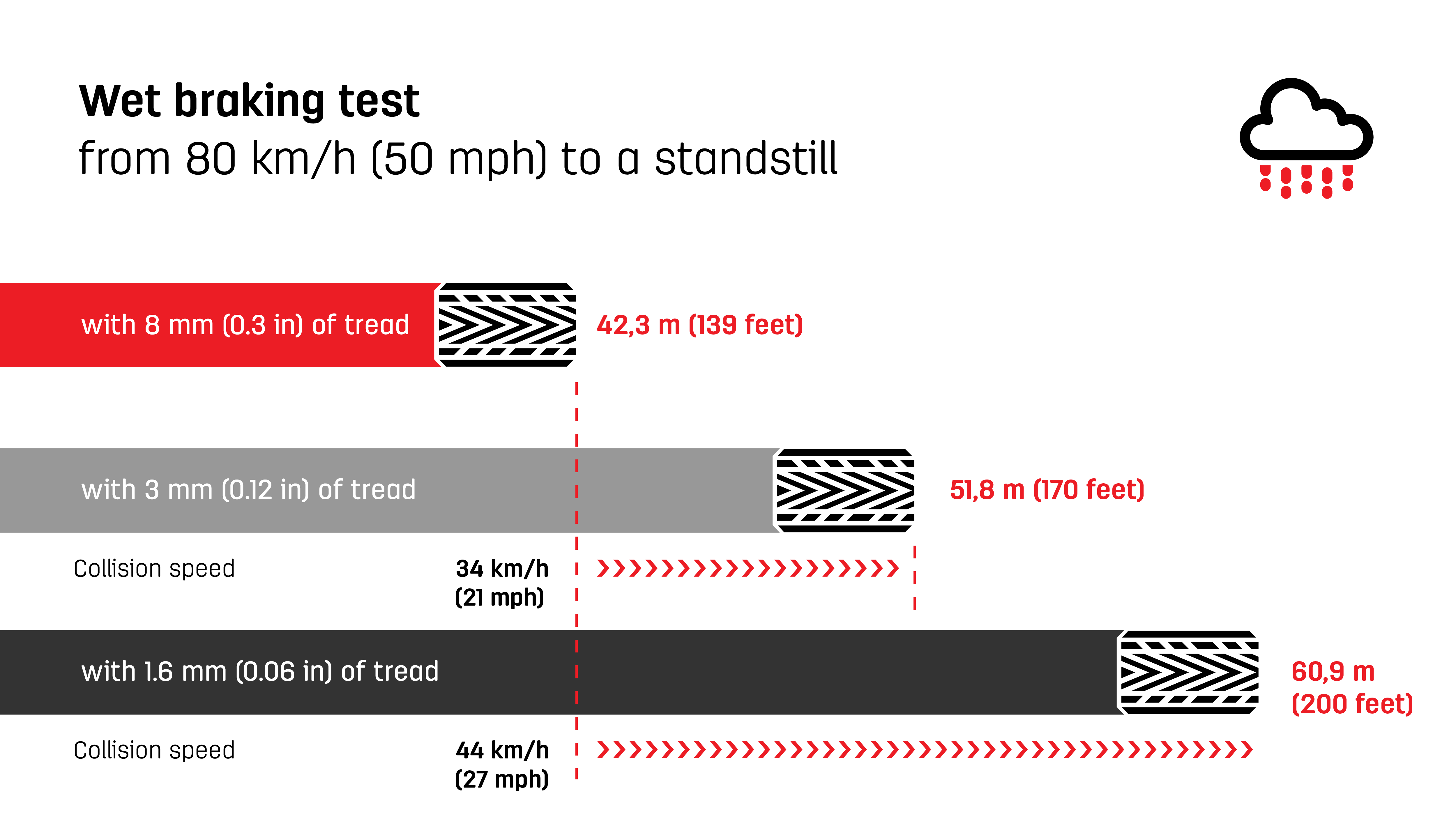It’s important that you know how to check your tyres’ tread depth. After all, the tread depth affects handling and provides grip with the road surface. The deeper it is, the more grip you’ll have.
 Tested by Continental Reifen Deutschland GmbH at the test location Contidrom (status: September 2020). Test conditions: 225/45 R 17, PremiumContact™ 6, wet road, from 80 km/h to 0 km/h, temperature 19,8 - 25,6° C. VW Golf 7 1.4 TSI. The graphics shown here are for illustration purposes only. The braking distance of a vehicle depends on its type, its age, the brakes and the tyres used, as well as the road surface. The full test report is available at www.continental-tires.com/car/tires/test-report-wet-braking-summer (Source: Continental Reifen Deutschland GmbH)
Tested by Continental Reifen Deutschland GmbH at the test location Contidrom (status: September 2020). Test conditions: 225/45 R 17, PremiumContact™ 6, wet road, from 80 km/h to 0 km/h, temperature 19,8 - 25,6° C. VW Golf 7 1.4 TSI. The graphics shown here are for illustration purposes only. The braking distance of a vehicle depends on its type, its age, the brakes and the tyres used, as well as the road surface. The full test report is available at www.continental-tires.com/car/tires/test-report-wet-braking-summer (Source: Continental Reifen Deutschland GmbH)
Optimal depths
A new car tyre begins life with approximately 8-9mm of tread depth. Legally, you can drive on them until they reach a minimum depth of the tread of 1.6 mm, across 75% of the tyre’s width and all around its circumference. However, consider that safe driving in wet and snowy weather conditions is affected by the tread depth, the pattern design and the rubber compound of the tread of your tyres. On wet or snow-covered roads braking performance will progressively decline with lower tread depths. On wet roads there is an additional increased risk of aquaplaning with fading tread depths.
Therefore, check your tyres regularly, reduce your speed on wet and snowy roads and consider replacing your tyres in good time.
Tread depth facts:
- New tyres have a tread depth of 8-9mm
- Legal minimum tread depth is 1.6mm
- Safe driving in wet and snowy weather conditions is affected by the tread depth, the pattern design and the rubber compound of the tread of your tyres.
- On wet and snow covered roads braking performance will progressively decline with lower tread depths
- Check your tyres regularly
- Reduce your speed on wet and snowy roads
- Consider replacing your tyres in good time
Checking your tyres’ tread depth
- First of all, check out the tread wear indicators that are built into the grooves of your tyres. These small horizontal bars are evenly spaced around the tyre’s circumference. Once your tyre has worn level with these bars, you have reached your minimum depth and your tyre will need replacing.
- Bear in mind though that these indicators tell you when you’ve reached 1.6mm and safe driving in wet and snowy weather might already be affected as mentioned above.
- A more accurate measurement can be taken using tyre gauges. These come in many different forms – from laminated cards with colour indicators to digital tyre depth gauges.
- Simply place the gauge into the tyre’s groove and you will see how close you are to reaching your minimum depth.
Related Topics
-
 2023/03/31Find out more about the differences between asymmetrical and directional tyre tread patterns, and discover how Uniroyal has combined the best of both with the RainSport 3.Which different tread patterns are there?Read more
2023/03/31Find out more about the differences between asymmetrical and directional tyre tread patterns, and discover how Uniroyal has combined the best of both with the RainSport 3.Which different tread patterns are there?Read more -
 2023/03/31We always recommend that tyres are repaired by professionals. They know whether it is safe or legal to repair a tyre, rather than replace it.Tyre repairRead more
2023/03/31We always recommend that tyres are repaired by professionals. They know whether it is safe or legal to repair a tyre, rather than replace it.Tyre repairRead more -
 2023/03/31Tyre care: We explain what to look out for and the best way to clean your tyres before storage. Find out more here now!Tyre careRead more
2023/03/31Tyre care: We explain what to look out for and the best way to clean your tyres before storage. Find out more here now!Tyre careRead more